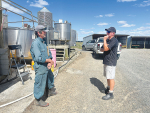Drench-resistant worms are widespread in New Zealand, and are common in sheep and cattle. The days are long past when farmers could simply buy the cheapest drench, assume it would do a reasonable job of killing worms, and then not worry about the future. Today, preventing and managing drench resistance must be a consideration in every worm control decision a farmer makes.
The use of combination drenches, is now a well-established tool in the fight against resistance. Modelling and in-the-field studies have shown the potential of combinations to slow the development of resistance.
Importantly, these studies all show that combinations have the greatest potential to slow resistance development when they are used before resistance has developed in the worm population. In other words, the best time to use combination drenches to minimise the development of resistance in Ostertagia in cattle is now, before it has developed significant resistance. Farmers should be discouraged from using single-active drenches of any kind.
Next, there is the issue of whether it is better to use orals, injections or pour-ons, or whether there is any difference between them. This last question is the easiest to answer and a quick look at the concentrations of active drug in the plasma following administration by the different routes will show this (figure 1).
It is well established that pour-ons deliver the lowest concentrations of drug into the bloodstream, both in respect of the peak concentration (maximum value) and the total volume (technically the area under the concentration curve). Also, delivery of drug by pour-on tends to be more variable, and penetration through the hide can be influenced by breed of cattle, weather (particularly if cold) and by animals licking either themselves or each other.
A recent AgResearch study found the drench moxidectin more effective against Cooperia in cattle when administered orally, than when given by injection or as a pour-on. The results showed that efficacy was poor for the injectable and pour-on routes (55.5% and 51.3%), but much better when the drug was delivered orally (91.1%). Efficacy against Ostertagia was good for all treatments, and this has been taken as evidence that all routes of administration are equal. This is far from the truth.
The conclusion of importance from the AgResearch study is that oral administration of moxidectin delivers a higher concentration of drug to the small intestine of cattle than does injection or pour-on, and that oral administration is also the least variable method.
Almost all the Cooperia populations in the study were resistant (this is true on almost every farm in New Zealand) and yet the oral killed more worms. This shows that the oral route must have delivered more drug to the small intestine, and that this resulted in the killing of more resistant worms. Other studies have shown the same effect in sheep.
The important point here is that these differences would not have been obvious against fully susceptible worms because they all tend to end up dead. Hence, it was important in this study that the worms were resistant, and that none of the treatments were completely effective. If they had been susceptible, as was the case for Ostertagia, then the differences would not have been seen.
A dose of drug which just manages to kill susceptible worms, but has little or no efficacy against resistant ones, will select for resistance faster than one which kills a good proportion of the resistant worms. This ability to kill emerging resistant worms is one of the major factors determining how fast resistance will develop.
So, the evidence, from a number of studies, is that the use of orals delivers more drug – of the endectocide class at least – to the small intestine and that this increased dose kills more resistant worms. Hence, for small intestinal species, the use of orals is likely to result in the slower development of resistance.
The situation with abomasal species such as Ostertagia is less clear. There are studies in sheep which show much higher delivery of endectocide drenches to both tissues and worms in the abomasum after oral administration than by injection, which resulted in higher efficacy. But, in other studies injections appear to be as good if not better against resistant worms which live in the abomasum. So, at this stage the jury is still out regarding orals and injections against worms which live in the abomasum. However, studies in deer in New Zealand show that pour-ons deliver far less drug to the abomasum than either injections or orals.
In summary then, drench resistance is a real threat to the cattle industries in New Zealand; resistance in Cooperia is widespread and resistance in Ostertagia has recently been confirmed on dairy and dairy-beef farms in the North Island.
Now is the time for farmers to take steps to prevent the problem getting worse. Choosing to use drenches which are least likely to select for resistance is the easiest thing a farmer can do to ensure sustainability.
Based on the evidence we have today the best products to use are oral combinations containing two, or even better three, classes of anthelmintic. If oral drenching is not possible then there are a number of injectable combination products available which should do a reasonable job. The use of single-active drenches, especially pour-ons, is most likely to lead to a resistance problem in the not-too-distant future.
• Dr Dave Leathwick is principal scientist, animal nutrition and health, AgResearch.









